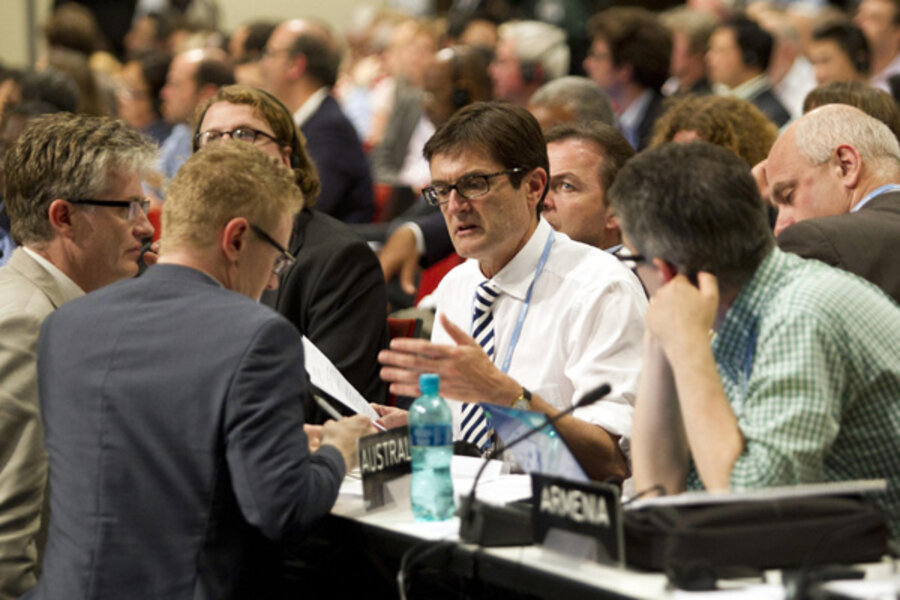While a deal sets up new climate talks, scientists help Africans adapt now
Loading...
| Johannesburg, South Africa
As the world enters a new phase of politically-charged climate talks, some scientists have focused on less-contentious projects like a famine early warning system that can help poor nations adapt to the planet's changes.
Negotiators from around the globe reached agreement today in Durban, South Africa on a way forward in the effort to curb greenhouse gas emissions. The deal extends the emissions targets set under the 1997 Kyoto Protocol and calls for a new round of negotiations to hammer out a replacement treaty, one that would aim to legally bind the US and fast-developing nations like China and India to meet emission cuts pledges.
But the new round of talks could take several years, followed by years more of ratification efforts. In the meantime, vulnerable populations in Africa and elsewhere may benefit more immediately from strategies to adapt to climate change.
For centuries, the patterns of rainfall and of the seasons have defined where people live on the continent and the security of their food supply These age-old ways are changing rapidly, leading to drought and famine. The most recent example is the ongoing food shortage in Somalia which many observers have described as Africa’s worst food security crisis in two decades.
Tens of thousands of people have lost their lives, and the situation remains serious. However, a project known as FEWS-NET, or the Famine Early Warning Systems Network, gave advance warning of the looming food crisis, and ensured that thousands of other lives were saved.
"We monitor food security and vulnerable populations," says scientist Jim Rowland at the US Geological Survey (USGS), which is part of FEWS-NET. "We started to create alerts about the present situation in Somalia in August 2010 after the upheaval in weather conditions following La Niña. We continued to send monthly updates until famine was declared in July 2011 based on much of our data."
As climate scientists and policymakers look ahead to the next round of climate treaty talks, there is a growing awareness of the need for new technologies to deal with the devastating environmental effects of climate change. And nowhere is this more true than in Africa, the continent where scientists say climate change has taken its greatest human toll.
Challiss McDonough of the World Food Programme confirms that technology systems like FEWS-NET are useful tools.
"FEWS-NET was among the first to predict that some areas of southern Somalia could slide into famine conditions, and that warning was instrumental in getting the attention of some donors before the crisis peaked," says McDonough.
While a worst-case scenario may have been avoided, international disagreement diminished the potential of the warning system. A regional conflict made it often difficult for aid workers to intervene successfully.
FEWS-NET was created initially by the United States after the 1984-85 famine in Ethiopia using satellite technology to help predict famines and to see how their effects might be minimized. FEWS-NET is sponsored by the US Agency for International Development (USAID) and other major US agencies such as NASA, the USGS, and the National Oceanic and Atmospheric Administration (NOOA) are key players.
FEWS-NET has evolved into a network that integrates information from a variety of sources, including remote satellite imaging and data gathered from local monitoring of conditions on the ground.
"We include, for example, information on market prices and other data, like rainfall figures," says Mr. Rowland. This use of multiple sources creates a more comprehensive picture of what is happening and how to alleviate problems.
FEWS-NET is also discovering plenty of evidence for ongoing, serious climate variability. "We’re finding out that in East Africa there will be more drought," Rowland says. "There is a connection between El Niño and La Niña, which is warming the Indian Ocean and changing rainfall patterns. More rain is now falling on the Indian Ocean and less on East Africa."
FEWS-NET was begun long before climate change was a global issue, but it has taken on new importance with rising temperatures and increasingly unpredictable weather cycles.
Emma Archer, a climate studies scientist at South Africa’s Council for Scientific and Industrial Research (CSIR), cautions that humans must choose to use the information wisely, unlike in Somalia recently where instability and slow donor reaction reduced the effectiveness of the aid effort.
"The best science and technology in the world can predict an appropriate response, but you need the political will to act," says Ms. Archer.
Still, the ultimate goal for FEWS-NET scientists is to create a base of long-term, consistent research. As Rowland says: "We are trying to see where will be the vulnerable areas 20, 30 years from now, based on present climate data."
Get daily or weekly updates from CSMonitor.com delivered to your inbox. Sign up today.





